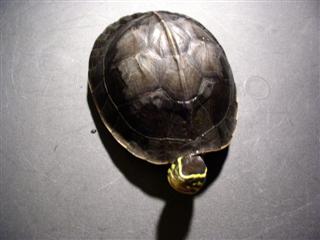Black Marsh Terrapin
Borneo Black Leaf Turtle, Smiling Terrapin, Black Mud Turtle, Malaysian Black Mud Turtle Scientific Name: Siebenrockiella crassicollis
Mon, 25th November, 2024 - 4:57 am GMT
Sponsor Ads:

Alternative Name
Borneo Black Leaf Turtle, Smiling Terrapin, Black Mud Turtle, Malaysian Black Mud Turtle Scientific Name: Siebenrockiella crassicollisBasic Info
The Black Marsh Terrapin's carapace can grow to nearly 8 inches in length (20 cm) and is usually entirely black, as are the limbs. The head is grey or black with white markings. The eyes are also surrounded by white. They have webbed feet and the carapace is distinguished by a central keel, rear serrations, and sometimes two lateral keels. They have broad heads and strong jaws that enable them to crunch the shells of mollusks and bones of the carrion.
Health
Captive Black Marsh Terrapins are happiest when fed on a diet resembling that in the wild, consisting of worms, snails, and other live aquatic animals as well as leafy green vegetables and fruits. They can also be fed commercial floating turtle food or cat or dog food, provided it is supplemented with live food. Juveniles can feed on bloodworms and commercial food that has been crushed. The turtle's water should be kept at about 80 degrees Fahrenheit and should be moderately shallow, with hiding places for the turtle. There should also be a land area with a basking lamp. The basking light should heat one area of the aquarium to about 85 degrees.Habitat
The Black Marsh Terrapin can be found in Southeastern Asia. They are most common in the swamps and marshes of Sumatra, Thailand, Borneo, Malaysia, and Java.Behavior
The Black Marsh Terrapin is also known as the Borneo Black Leaf Turtle, the Smiling Terrapin, the Black Mud Turtle, or the Malaysian Black Mud Turtle. While common in their native Southeastern Asia, they are very shy and are rarely seen. They are not commonly kept in captivity. Making its home in shallow, densely vegetated warm water, the Black Marsh Terrapin spends most of its time burrowed in the mud. They will, however, venture into deeper water and onto land to bask in the sun.Origin
Southeast AsiaHistory
N/ACommon Foods
They are omnivorous in the wild and usually feed on plant matter, worms, bugs, snails, frogs, and shrimp that make their home in the same water as the turtles, though they sometimes scavenge for carrion and other foods on land at night.Sponsor Ads:
Language is the house of the truth of Being. --Martin Heidegger
Black Marsh Terrapin
Coded by: BGID® | ALL RIGHTS RESERVED Copyright © 2000-2024
Disclaimer | Privacy | Report Errors / Contact | Credits








 Homosexual behavior stems from the mind or genetics?
Homosexual behavior stems from the mind or genetics?  The Best Text Adventure You Will Ever Play! The official site:
The Best Text Adventure You Will Ever Play! The official site:  Why haven't we as a collective earth met with aliens yet?
Why haven't we as a collective earth met with aliens yet?  World EcoSystem - Biodiversity Changes - Who is on board and who isn
World EcoSystem - Biodiversity Changes - Who is on board and who isn  Mouthwash - Mouthrinse - Mouth Sores - Healing Infections - Gingivitis
Mouthwash - Mouthrinse - Mouth Sores - Healing Infections - Gingivitis  Treatment for Depression
Treatment for Depression  Ultra radical and violent Islamist group that even rivals Al Qaeda
Ultra radical and violent Islamist group that even rivals Al Qaeda  An idea to have teachers who want to carry guns to school undergo some level of police training will be left up to local school districts and police departments.
An idea to have teachers who want to carry guns to school undergo some level of police training will be left up to local school districts and police departments.